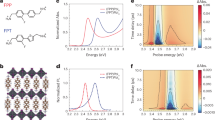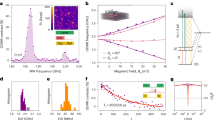Abstract
Realizing strong nonlinear optical responses is a long-standing goal of both fundamental and technological importance. Recently, substantial efforts have been focused on exploring excitons in solids to achieve nonlinearities even down to few-photon levels. However, a crucial tradeoff arises as strong light–matter interactions require large oscillator strength and short radiative lifetime of excitons, which limits their nonlinearity. Here we experimentally demonstrate strong nonlinear optical responses with large oscillator strength by exploiting the coupling between excitons and carriers in an atomically thin semiconductor. By controlling the electric field and electrostatic doping of trilayer WSe2, we observe the hybridization between intralayer and interlayer excitons and the formation of Fermi polarons. Substantial optical nonlinearity is observed under continuous-wave and pulsed laser excitation, where the Fermi polaron resonance blueshifts by as much as ~10 meV. Intriguingly, we observe a remarkable asymmetry in the optical nonlinearity between electron and hole doping, which is tunable by the applied electric field. We attribute these features to the optically induced valley polarization due to the interactions between excitons and free charges. Our results establish atomically thin heterostructures as a highly versatile platform for engineering nonlinear optical response with applications to classical and quantum optoelectronics.
This is a preview of subscription content, access via your institution
Access options
Access Nature and 54 other Nature Portfolio journals
Get Nature+, our best-value online-access subscription
$29.99 / 30 days
cancel any time
Subscribe to this journal
Receive 12 print issues and online access
$209.00 per year
only $17.42 per issue
Buy this article
- Purchase on Springer Link
- Instant access to full article PDF
Prices may be subject to local taxes which are calculated during checkout




Similar content being viewed by others
Data availability
All other data are available from the corresponding author upon reasonable request. Source data are provided with this paper.
References
Volz, T. et al. Ultrafast all-optical switching by single photons. Nat. Photon. 6, 605–609 (2012).
Boyd, R. W. Nonlinear Optics (Academic Press, 2003).
Zasedatelev, A. V. et al. Single-photon nonlinearity at room temperature. Nature 597, 493–497 (2021).
Chang, D. E., Sørensen, A. S., Demler, E. A. & Lukin, M. D. A single-photon transistor using nanoscale surface plasmons. Nat. Phys. 3, 807–812 (2007).
Sun, S., Kim, H., Luo, Z., Solomon, G. S. & Waks, E. A single-photon switch and transistor enabled by a solid-state quantum memory. Science 361, 57–60 (2018).
Datta, B. et al. Highly nonlinear dipolar exciton–polaritons in bilayer MoS2. Nat. Commun. 13, 6341 (2022).
Delteil, A. et al. Towards polariton blockade of confined exciton–polaritons. Nat. Mater. 18, 219–222 (2019).
Muñoz-Matutano, G. et al. Emergence of quantum correlations from interacting fibre-cavity polaritons. Nat. Mater. 18, 213–218 (2019).
Mak, K. F. & Shan, J. Opportunities and challenges of interlayer exciton control and manipulation. Nat. Nanotechnol. 13, 974–976 (2018).
Wilson, N. P., Yao, W., Shan, J. & Xu, X. Excitons and emergent quantum phenomena in stacked 2D semiconductors. Nature 599, 383–392 (2021).
Wild, D. S., Shahmoon, E., Yelin, S. F. & Lukin, M. D. Quantum nonlinear optics in atomically thin materials. Phys. Rev. Lett. 121, 123606 (2018).
Liu, X. et al. Strong light–matter coupling in two-dimensional atomic crystals. Nat. Photon. 9, 30–34 (2015).
Barachati, F. et al. Interacting polariton fluids in a monolayer of tungsten disulfide. Nat. Nanotechnol. 13, 906–909 (2018).
Regan, E. C. et al. Emerging exciton physics in transition metal dichalcogenide heterobilayers. Nat. Rev. Mater. 7, 778–795 (2022).
Zhang, L. et al. Highly valley-polarized singlet and triplet interlayer excitons in van der Waals heterostructure. Phys. Rev. B 100, 041402 (2019).
Rivera, P. et al. Valley-polarized exciton dynamics in a 2D semiconductor heterostructure. Science 351, 688–691 (2016).
Walther, V., Johne, R. & Pohl, T. Giant optical nonlinearities from Rydberg excitons in semiconductor microcavities. Nat. Commun. 9, 1309 (2018).
Leisgang, N. et al. Giant Stark splitting of an exciton in bilayer MoS2. Nat. Nanotechnol. 15, 901–907 (2020).
Louca, C. et al. Interspecies exciton interactions lead to enhanced nonlinearity of dipolar excitons and polaritons in MoS2 homobilayers. Nat. Commun. 14, 3818 (2023).
Wang, Z., Chiu, Y. H., Honz, K., Mak, K. F. & Shan, J. Electrical tuning of interlayer exciton gases in WSe2 bilayers. Nano Lett. 18, 137–143 (2018).
Scuri, G. et al. Electrically tunable valley dynamics in twisted WSe2/WSe2 bilayers. Phys. Rev. Lett. 124, 217403 (2020).
Movva, H. C. P. et al. Tunable Γ-K valley populations in hole-doped trilayer WSe2. Phys. Rev. Lett. 120, 107703 (2018).
Sidler, M. et al. Fermi polaron–polaritons in charge-tunable atomically thin semiconductors. Nat. Phys. 13, 255–261 (2017).
Mak, K. F. et al. Tightly bound trions in monolayer MoS2. Nat. Mater. 12, 207–211 (2013).
Wang, Z., Zhao, L., Mak, K. F. & Shan, J. Probing the spin-polarized electronic band structure in monolayer transition metal dichalcogenides by optical spectroscopy. Nano Lett. 17, 740–746 (2017).
Erkensten, D., Brem, S. & Malic, E. Exciton–exciton interaction in transition metal dichalcogenide monolayers and van der Waals heterostructures. Phys. Rev. B 103, 045426 (2021).
Jones, A. M. et al. Spin-layer locking effects in optical orientation of exciton spin in bilayer WSe2. Nat. Phys. 10, 130–134 (2014).
Gong, Z. et al. Magnetoelectric effects and valley-controlled spin quantum gates in transition metal dichalcogenide bilayers. Nat. Commun. 4, 2053 (2013).
Zhang, Y. et al. Every-other-layer dipolar excitons in a spin–valley locked superlattice. Nat. Nanotechnol. 18, 501–506 (2023).
Stepanov, P. et al. Exciton–exciton interaction beyond the hydrogenic picture in a MoSe2 monolayer in the strong light–matter coupling regime. Phys. Rev. Lett. 126, 167401 (2021).
Scuri, G. et al. Large excitonic reflectivity of monolayer MoSe2 encapsulated in hexagonal boron nitride. Phys. Rev. Lett. 120, 37402 (2018).
Wang, G. et al. Valley dynamics probed through charged and neutral exciton emission in monolayer WSe2. Phys. Rev. B 90, 075413 (2014).
Hsu, W.-T. et al. Optically initialized robust valley-polarized holes in monolayer WSe2. Nat. Commun. 6, 8963 (2015).
Courtade, E. et al. Charged excitons in monolayer WSe2: experiment and theory. Phys. Rev. B 96, 085302 (2017).
Fey, C., Schmelcher, P., Imamoglu, A. & Schmidt, R. Theory of exciton–electron scattering in atomically thin semiconductors. Phys. Rev. B 101, 195417 (2020).
Yan, T., Yang, S., Li, D. & Cui, X. Long valley relaxation time of free carriers in monolayer WSe2. Phys. Rev. B 95, 241406 (2017).
Goryca, M., Wilson, N. P., Dey, P., Xu, X. & Crooker, S. A. Detection of thermodynamic ‘valley noise’ in monolayer semiconductors: access to intrinsic valley relaxation time scales. Sci. Adv. 5, eaau4899 (2019).
Yang, L. et al. Long-lived nanosecond spin relaxation and spin coherence of electrons in monolayer MoS2 and WS2. Nat. Phys. 11, 830–834 (2015).
Dery, H. & Song, Y. Polarization analysis of excitons in monolayer and bilayer transition-metal dichalcogenides. Phys. Rev. B 92, 125431 (2015).
Robert, C. et al. Spin/valley pumping of resident electrons in WSe2 and WS2 monolayers. Nat. Commun. 12, 5455 (2021).
Park, H. et al. Dipole ladders with large Hubbard interaction in a moiré exciton lattice. Nat. Phys. 19, 1286–1292 (2023).
Gao, B. et al. Excitonic Mott insulator in a Bose–Fermi–Hubbard system of moiré WS2/WSe2 heterobilayer. Nat. Commun. 15, 2305 (2024).
Xiong, R. et al. Correlated insulator of excitons in WSe2/WS2 moiré superlattices. Science 380, 860–864 (2023).
Koshelev, K. et al. Subwavelength dielectric resonators for nonlinear nanophotonics. Science 367, 288–292 (2020).
Bekenstein, R. et al. Quantum metasurfaces with atom arrays. Nat. Phys. 16, 676–681 (2020).
Cai, T. et al. Radiative enhancement of single quantum emitters in WSe2 monolayers using site-controlled metallic nanopillars. ACS Photonics 5, 3466–3471 (2018).
Yu, H., Liu, G. B., Tang, J., Xu, X. & Yao, W. Moiré excitons: from programmable quantum emitter arrays to spin–orbit-coupled artificial lattices. Sci. Adv. 3, e1701696 (2017).
Zhou, Y. et al. Controlling excitons in an atomically thin membrane with a mirror. Phys. Rev. Lett. 124, 27401 (2020).
Aspelmeyer, M., Kippenberg, T. J. & Marquardt, F. Cavity optomechanics. Rev. Mod. Phys. 86, 1391–1452 (2014).
Van Stryland, E. W., Wu, Y. Y., Hagan, D. J., Soileau, M. J. & Mansour, K. Optical limiting with semiconductors. J. Opt. Soc. Am. B 5, 1980–1988 (1988).
Acknowledgements
This research is primarily supported by the US Department of Energy, Office of Science, Office of Basic Energy Sciences Early Career Research Program, under award no. DE-SC-0022885. The fabrication of samples is supported by the National Science Foundation CAREER Award under award no. DMR-2145712. This research used Quantum Material Press (QPress) of the Center for Functional Nanomaterials (CFN), which is a US Department of Energy, Office of Science User Facility, at Brookhaven National Laboratory under contract no. DE-SC0012704. K.W. and T.T. acknowledge support from the JSPS KAKENHI (grant nos. 20H00354, 21H05233 and 23H02052) and World Premier International Research Center Initiative (WPI), MEXT, Japan, for hBN synthesis.
Author information
Authors and Affiliations
Contributions
Y.Z. and L.G. conceived the project. L.G. fabricated the samples and performed the experiments. L.Z., R.N., S.P. and H.J. assisted with the sample fabrication. L.Z. and R.N. helped with the optical measurements. M.X., D.S.W., M.H. and Y.Z. contributed to the data analysis and theoretical understanding. T.T. and K.W. provided the hBN samples. L.G. and Y.Z. wrote the paper with extensive input from the other authors.
Corresponding author
Ethics declarations
Competing interests
The authors declare no competing interests.
Peer review
Peer review information
Nature Photonics thanks Xi Wang and the other, anonymous, reviewer(s) for their contribution to the peer review of this work.
Additional information
Publisher’s note Springer Nature remains neutral with regard to jurisdictional claims in published maps and institutional affiliations.
Supplementary information
Supplementary information
Supplementary Figs. 1–13 and Table 1.
Source data
Source Data Fig. 1
Numerical source data for Fig. 1c–e.
Source Data Fig. 2
Numerical source data for Fig. 2a–e.
Source Data Fig. 4
Numerical source data for Fig. 4a–d.
Rights and permissions
Springer Nature or its licensor (e.g. a society or other partner) holds exclusive rights to this article under a publishing agreement with the author(s) or other rightsholder(s); author self-archiving of the accepted manuscript version of this article is solely governed by the terms of such publishing agreement and applicable law.
About this article
Cite this article
Gu, L., Zhang, L., Ni, R. et al. Giant optical nonlinearity of Fermi polarons in atomically thin semiconductors. Nat. Photon. (2024). https://doi.org/10.1038/s41566-024-01434-x
Received:
Accepted:
Published:
DOI: https://doi.org/10.1038/s41566-024-01434-x



